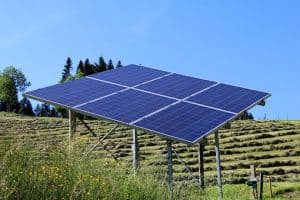[fusion_builder_container hundred_percent=”yes” overflow=”visible”][fusion_builder_row][fusion_builder_column type=”1_1″ background_position=”left top” background_color=”” border_size=”” border_color=”” border_style=”solid” spacing=”yes” background_image=”” background_repeat=”no-repeat” padding=”” margin_top=”0px” margin_bottom=”0px” class=”” id=”” animation_type=”” animation_speed=”0.3″ animation_direction=”left” hide_on_mobile=”no” center_content=”no” min_height=”none”]

ALSO POSTED BY:
Huffington Post
8 August 2011
We in the United States are very familiar with energy wars. Our long-time national energy strategy, as former U.S. Sen. Gary Hart points out, is to send our children off to kill and be killed in foreign lands to protect our access to oil.
For those of you who haven’t followed this notable development, here’s an account.
It has been widely reported that the U.S. armed forces are going green. The Department of Defense (DoD) has resolved to cut its energy intensity 30% by 2015, obtain a quarter of its energy from renewable resources by 2020, cut petroleum use 20% by 2015, significantly reduce its greenhouse gas emissions and power jets and ships with biofuels. Each of the four branches of the armed services has set its own green goals, including a push to eliminate waste and achieve net-zero energy and water consumption at Army and Navy installations.
Congress is beginning to pay attention. Last month, U.S. Sen. Mark Udall (D-CO) partnered with E3G, the Environment and Energy Study Institute and the Truman National Security Project to brief congressional staff on what the military is planning and why. A panel of three defense officials and a veteran of the Iraq and Afghanistan wars drew a standing-room-only crowd. (Go here for recordings of the presentations.)
Four members of the House – Democrats Gabrielle Giffords and Maurice Hinchey, and Republicans Roscoe Bartlett and Jack Kingston – have formed a Defense Energy Security Caucus to educate their peers and the public about the strategic value of sustainable energy. They also plan to help the Pentagon remove the barriers it encounters in the transition. The caucus quickly attracted 19 members.
A green military also is drawing interest from the House and Senate Renewable Energy and Energy Efficiency Caucuses, the Senate Energy and Natural Resources Committee, and other congressional committees that oversee military, intelligence and energy policy.
If the military achieves its energy efficiency and renewable energy goals, we’ll see significant environmental benefits from the world’s largest institutional energy consumer. Taxpayers will save money as the military weans itself from oil, including fuel that costs as much as $400 a gallon by the time it reaches troops on the battlefield.
And if the military diverts billions of dollars from finite fuels to solar, wind and biomass technologies, it could become a game-changer in the domestic energy market. As the Environmental Defense Fund has documented, there are hundreds of U.S. companies that could create new jobs by building, servicing and using sustainable energy technologies. Many of them are located in the districts of politicians who are opposing intelligent energy and environmental policies.
However, none of those benefits are what drives the Pentagon’s interest in green fuels. It’s all about saving the lives of American soldiers, making military bases more resilient and improving the military’s ability to fight wars – as well as its ability to provide humanitarian assistance overseas and improve international stability by helping nations build their economies.
Predictably, the military’s energy shift is not without its skeptics and opponents. The skeptics include Rear Adm. Robert James (USN, ret.), who wrote this in an op-ed for the Wall Street Journal: “Although few realize it, the military is just as susceptible to fads and political correctness as any other government agency.” Towering wind turbines and sprawling solar arrays will make it easy for the enemy to detect front-line positions, James argues, and the military’s bio-fuel goals will require massive amounts of land.
In the House of Representatives, conservatives and oil-state Democrats are trying to make sure the oil industry doesn’t lose one of its biggest customers. They’ve been trying to repeal a 2007 law that prohibits the military from buying oil from tar sands and liquid fuels from coal. Never mind that those fuels consume far more water and produce far more carbon emissions than conventional oil, or that the convoys needed to deliver fossil fuels to the front lines are arguably the military’s greatest vulnerability and the soldiers’ deadliest duty. Thousands of soldiers and civilians have died trying to protect fuel convoys in Iraq and Afghanistan.
There are a few important points the skeptics and opponents don’t understand, or refuse to acknowledge.
First, in the great scheme of things, fossil energy is the real fad. It has been a 200-year diversion from solar, wind, hydro- and bio-power, beneficial in its time, but now a dead-end addiction. The fossil fad has become too dangerous and too expensive not only for the armed forces, but for the nation. The fossil energy fad is destined to end, either rationally and deliberately, or by dangerous and disruptive default.
Second, the military’s transition to more sustainable energy is part of a critical, necessary and long-overdue shift in how we think of security. We are moving from the paradigm of guns to a paradigm of plowshares. In the past, security meant building more powerful weapons to contain threats outside our borders.
Our more enlightened thinkers now define security as a condition that depends as much on strong communities as military muscle.
For example, discussing a book he co-authored last year titled “The Ultimate Weapon is No Weapon”, Army Lt. Col. Shannon Beebe writes:
The concept of security has far too long been interpreted too narrowly: as a security of territory from external aggression, or as protection of national interests in foreign policy or as global security from the threat of nuclear holocaust. It has been related to nation-states more than people…Forgotten were the legitimate concerns of ordinary people who sought security in their daily lives. For many of them, security symbolized protection from the threat of diseases, hunger, unemployment, crime [/fusion_builder_column][fusion_builder_column type=”1_1″ background_position=”left top” background_color=”” border_size=”” border_color=”” border_style=”solid” spacing=”yes” background_image=”” background_repeat=”no-repeat” padding=”” margin_top=”0px” margin_bottom=”0px” class=”” id=”” animation_type=”” animation_speed=”0.3″ animation_direction=”left” hide_on_mobile=”no” center_content=”no” min_height=”none”][or terrorism], social conflict, political repression and environmental hazards. With the dark shadows of the Cold War receding, one can see that many conflicts are within the nations rather that between the nations.
Col. Beebe is not a lightweight. A graduate of West Point, he has served in combat and “stability deployments” around the world. He’s regarded as one of the military’s leading thinkers on 21st century “security architectures”, climate change and environmental security.
Another example is the widely published essay, “A National Strategic Narrative“, co-authored by Col. Mark Mykleby and Capt. Wayne Porter earlier this year. Mykleby, now retired from the Marines, co-wrote the essay while serving as a senior advisor to the Chairman of the Joint Chiefs of Staff. Mykleby and Porter argue that modern security depends on the United States becoming an international leader in sustainability at every level of society.
These thoughts are now incorporated into official U.S. policy. President Obama’s 2010 National Security Strategy concludes:
Our diplomacy and development capabilities must help prevent conflict, spur economic growth, strengthen weak and failing states, lift people out of poverty, combat climate change, and strengthen institutions of democratic governance.
DoD’s 2011 National Military Strategy points out:
Preventing wars is as important as winning them, and far less costly.
The operations manual issued by the Army’s brain trust in 2008 calls for the use of “soft power” — the collaboration of many different agencies of government to help unstable nations build strong institutions and thriving economies.
However, international stability will not be possible in a world suffering catastrophic impacts of global climate change or intensifying competition for finite resources. The exercise of “soft power” must include what Amory Lovins calls the “soft energy path“. There is nothing softheaded about it.
The idea that global security is rooted in people and communities is not new; it has just taken a long time to trickle up to the top levels of the U.S. defense and intelligence communities. I wrote about it 30 years ago after a tour in Vietnam, in an essay titled “The Indefensible Society”:
Though we may be confused and frightened, we can see the dim outlines of a new world order much different from the old. It is an order promoting life rather than death, peace rather than terror, self-realization rather than frustration, community rather than alienation and personal opportunity rather than powerlessness. From this new order, we can construct a “defense plan” which allows each of us to be not a terrified bystander to the drama of international affairs, but a direct participant in the healing of the planet, contributing to world security daily in our homes and workplaces…The plan begins with the assumption that we are insecure not because we lack sufficient military forces, but because we lack internal coherence as people, as a society and as a community of nations.
In other words, genuine security is more about fabric than fortress – more about building the strength and resilience of every household, every business and every community, each a thread in the fabric of society. The military’s embrace of sustainable energy is a very important step in that direction.
Let the skeptics make their case. Constructive skepticism will sharpen the military’s plowshares. But the bottom line is hard to deny: A green military will provide us not only with greater security at less cost; in these very turbulent times, it also can become the seedbed of economic stability and lasting prosperity. Those are goals worth fighting for.
 Follow William S. Becker on Twitter: www.twitter.com/sustainabill
Follow William S. Becker on Twitter: www.twitter.com/sustainabill
[/fusion_builder_column][/fusion_builder_row][/fusion_builder_container]

Leave a Reply